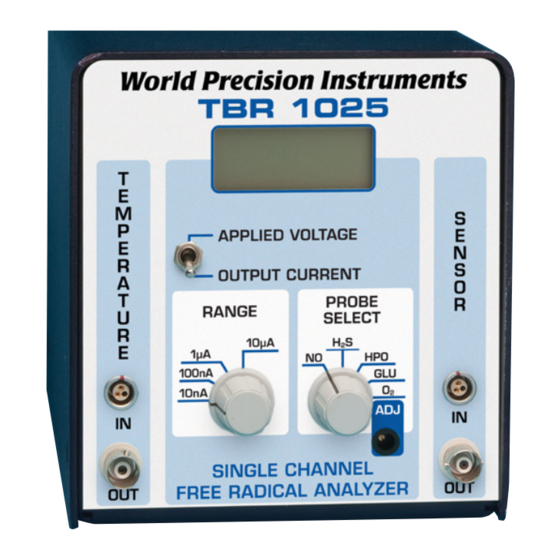
Subscribe to Our Youtube Channel
Summary of Contents for WPI ISO-H2S-2
- Page 1 WORLD PRECISION INSTRUMENTS Instrumenting scientific ideas INSTRUCTION MANUAL ISO-H2S-2 Hydrogen Sulfide Sensor for use with WPI Analyzers Serial No._____________________ www.wpiinc.com 030316...
- Page 2 Other WPI Favorites Free Radical Analyzer • Real-time detection using electrochemical microsensors • Measure nitric oxide from < 0.3 nM to 100µM. • Measure hydrogen peroxide < 10 nM to 100mM • Measure hydrogen sulfide • Measure glucose • Measure oxygen from 0.1% to 100% •...
-
Page 3: Table Of Contents
ISO-H2S-2 CONTENTS ABOUT THIS MANUAL ........................1 INTRODUCTION ..........................1 Notes and Warnings ......................... 1 Parts List ............................2 Unpacking ........................... 2 INSTRUMENT DESCRIPTION ......................2 OPERATING INSTRUCTIONS ......................3 Polarizing the Sensor ....................... 3 Calibrating the Sensor ......................4 Preparing Na S Stock Solution .................. - Page 4 World Precision Instruments...
-
Page 5: About This Manual
Fig. 1—The ISO-H2S-2 sensor works with WPI free radical analyzers to monitor hydrogen sulfide. INTRODUCTION The basic structure of the ISO-H2S-2 sensor is shown in Fig. 2. It consists of an internal H S-sensing working/reference electrode combination. This electrode fits... -
Page 6: Parts List
Concealed damage should be reported at once to the carrier and an inspection requested. Please read the section entitled “Claims and Returns” on page 15 of this manual. Please contact WPI Customer Service if any parts are missing at 941.371.1003 or customerservice@wpiinc.com. -
Page 7: Operating Instructions
Probe Select switch to H S (150mV). Plug in the ISO-H2S-2 sensor and allow it to polarize up to 12 hours to reach a stable baseline current of <75000pA before it is used for measurement. During initial polarization the current is typically high, but within an hour it will be- gin to decrease rapidly. -
Page 8: Calibrating The Sensor
Immerse the ISO-H2S-2 sensor in the solution and secure it in an electrode holder such as WPI’s Pro-Guide (WPI #47510, 47520, 47530, 47540) or a micro- manipulator. - Page 9 ISO-H2S-2 The reaction produces H S gas. When H S gas passes through the gas permeable membrane, it generates an output current that is measurable, and the results can then be graphed. This corresponds to 1µM, 2µM and 4µM final concentrations, respectively.
- Page 10 Amount added S] nM Response (pA) 20µL 3986.76 40µL 1994 6717.67 80µL 3972 10077.81 Construct a standard calibration curve using the recorded data. Using a third party spreadsheet with graphing capability like Microsoft Excel, it is possible to ® generate a linear regression analysis that will display the equation and the R coefficient.
-
Page 11: Maintenance
If the sensor was used in a protein-rich solution, the membrane tip should first be soaked in a protease solution for several minutes to remove protein build-up, and then in distilled water. Enzymatic detergent (Enzol, WPI #7363) can also be used. The membrane sleeves can also be sterilized chemically using an appropriate disinfectant (Cidex, WPI #7364). -
Page 12: Replacing The Membrane Sleeve
Additional membrane sleeves (WPI#600016) may be pur- chased separately. Dip the internal electrode 1–2cm into the ISO-H2S electrolyte (WPI #100084) provided in the start-up kit. The current will rise rapidly offscale. Using the MicroFil™ nonmetallic syringe needle (WPI #MF28G67-5) and 1mL plastic syringe (included in the Startup kit) inject approximately 100µL of electrolyte directly into... -
Page 13: Accessories
(1M). If the current increases dramatically or is offscale then the membrane integrity is not good and a new membrane will have to be fitted. Additional ISO-H2S-2 membranes (packages of 4) are available (WPI #600016). -
Page 14: Troubleshooting
See “Replacing the Membrane Sleeve” on page 8. NOTE: If you have a problem/issue with that falls outside the definitions of this troubleshooting section, contact the WPI Technical Support team at 941.371.1003 or technicalsupport@wpiinc.com. World Precision Instruments... -
Page 15: Specifications
ISO-H2S-2 SPECIFICATIONS The sensor conforms to the following specifications: Outside Diameter Response Time < 10 sec Detection LImit/Range <5nM Nominal Sensitivity (New sensor) >1 pA/nM Poise Voltage 150mV Typical Quiescent Baseline Current, 25ºC <75000pA Acceptable Baseline Range 1000-8000pA Baseline Noise (pA) <10pA... - Page 16 World Precision Instruments...
-
Page 17: Index
ISO-H2S-2 INDEX Symbols returns 2 5399 9 Kimwipes 7, 8 7363-4 9 saline solution 9 13661 9 linear regression 6 salinity 6 100084 1, 2, 9 locking cap 1, 3 scatter plot 6 600015 3, 9 sensitivity 10 600016 1, 3, 9 sleeve 1, 3 membrane 1, 3 slope 6... -
Page 18: Declaration Of Conformity
DECLARATION OF CONFORMITY World Precision Instruments... -
Page 19: Warranty
WPI shall not be liable for any damage to data or property that may be caused directly or indirectly by use of this product. - Page 20 International Trade Center, 175 Sarasota Center Blvd., Sarasota FL 34240-9258 Tel: 941-371-1003 • Fax: 941-377-5428 • E-mail: sales@wpiinc.com 1 Hunting Gate, Hitchin, Hertfordshire SG4 0TJ Tel: 44 (0)1462 424700 • Fax: 44 (0)1462 424701 • E-mail: wpiuk@wpi-europe.com Germany Zossener Str. 55, 10961 Berlin Tel: 030-6188845 •...




Need help?
Do you have a question about the ISO-H2S-2 and is the answer not in the manual?
Questions and answers